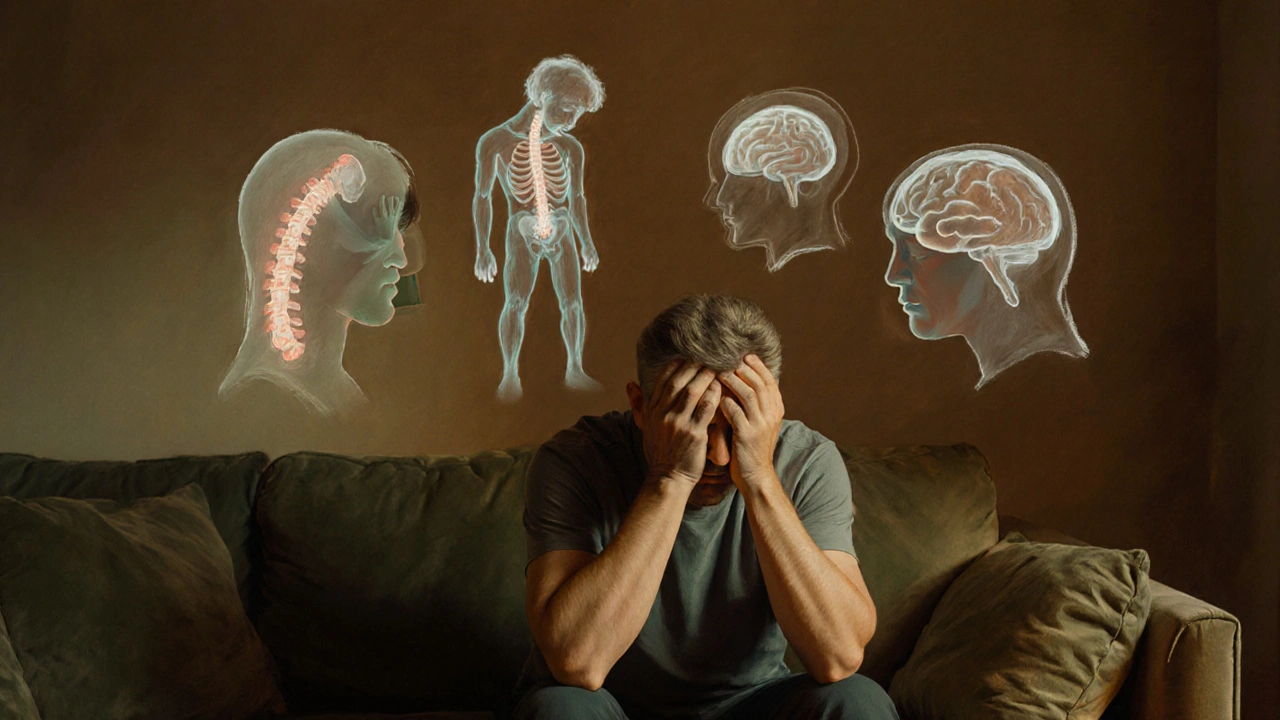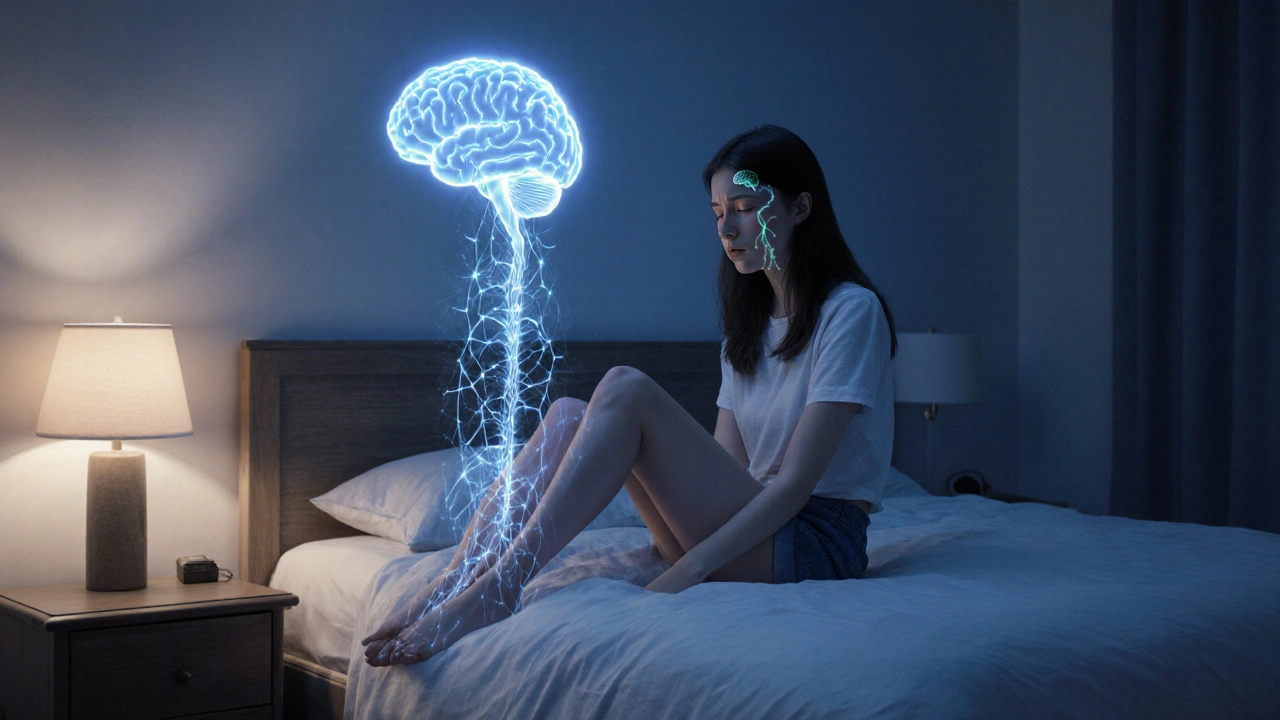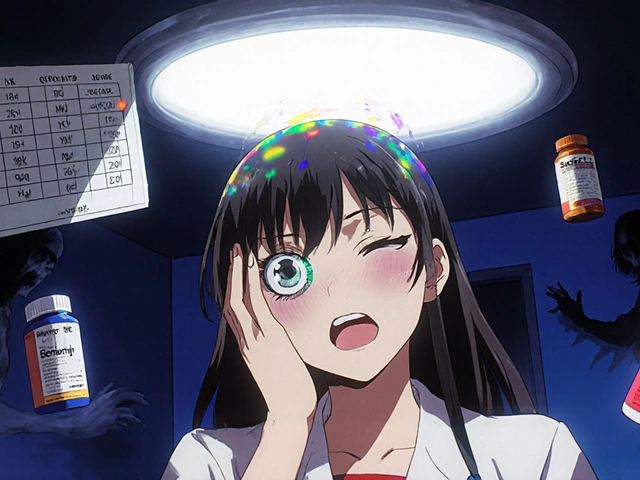Restless Leg Syndrome is a neurological movement disorder that causes an irresistible urge to move the legs, often accompanied by uncomfortable sensations. It typically worsens at night and can disrupt sleep, leading to daytime fatigue and mood changes.
Why RLS Matters for Your Mind
When the legs won’t stay still, the brain stays on high alert. The constant irritation triggers the sympathetic nervous system, releasing stress hormones like cortisol. Over weeks or months, that stress can seep into emotional well‑being, making anxiety and low mood more likely. A 2023 epidemiological study found that people with RLS are 1.8times more prone to clinical anxiety than the general population.
Common Mental Health Conditions Linked to RLS
Anxiety is a mental health disorder characterized by excessive worry, tension, and physical symptoms such as restlessness. In RLS patients, the nightly limb urges can act as a perpetual stressor, heightening the fight‑or‑flight response.
Depression involves persistent low mood, loss of interest, and fatigue. Chronic sleep loss from RLS contributes to the neurochemical imbalance that fuels depressive episodes.
Both conditions share a bidirectional relationship with RLS: worsening leg symptoms can deepen mood disorders, while severe anxiety or depression can magnify the perception of leg discomfort.
Biological Overlaps: Dopamine & Iron Deficiency
Dopamine is a neurotransmitter that regulates movement and reward pathways. Low dopaminergic activity is a core feature of RLS, and dopamine deficits are also implicated in depression and certain anxiety disorders.
Iron deficiency reduces dopamine synthesis, creating a cascade that worsens both leg symptoms and mood regulation. Blood‑test data from a 2022 clinical trial showed that raising serum ferritin above 75µg/L improved RLS severity scores by 30% and reduced depressive symptom scores by 20%.
Sleep Disturbance: The Hidden Bridge
Sleep disturbance encompasses difficulty falling asleep, staying asleep, or achieving restorative deep‑sleep stages. RLS frequently causes fragmented sleep, leading to reduced REM cycles, which are crucial for emotional processing.
When REM sleep is cut short, the brain’s ability to regulate mood and stress hormones declines, setting the stage for anxiety, irritability, and depressive spikes. A longitudinal survey of 5,000 adults showed that nightly awakenings due to RLS predicted a 42% increase in reported depressive symptoms over a two‑year period.
Quality of Life: The Bigger Picture
Quality of life measures overall well‑being, including physical health, mental state, and social functioning. RLS‑related pain, sleep loss, and mood swings collectively erode daily satisfaction, work performance, and relationships.
Patients often report feeling “tired all the time,” missing out on family activities, or avoiding social gatherings because of leg discomfort. This withdrawal can further isolate them, amplifying the mental health burden.

Managing RLS While Protecting Mental Health
- Medication review: Dopamine agonists (e.g., pramipexole) target both movement and mood pathways. However, side‑effects like impulse control problems should be monitored.
- Iron supplementation: Oral ferrous sulfate or IV iron infusions raise ferritin levels, supporting dopamine production and mood stability.
- Cognitive‑behavioral therapy for insomnia (CBT‑I): Tackles sleep‑related anxiety, teaches relaxation techniques, and improves sleep continuity.
- Physical routines: Stretching, low‑impact yoga, or cycling before bed eases leg sensations and reduces cortisol spikes.
- Mindfulness and stress reduction: Daily meditation lowers baseline cortisol, helping the brain tolerate RLS urges without spiraling into panic.
Related Conditions - How They Compare
| Condition | Primary Symptom | Typical Trigger | Prevalence (Adults) | First‑Line Treatment |
|---|---|---|---|---|
| Restless Leg Syndrome | Urge to move legs with uncomfortable sensations | Inactivity, evening/nighttime | ≈10% | Dopamine agonist, iron supplementation |
| Periodic Limb Movement Disorder (PLMD) | Rhythmic leg jerks during sleep | Sleep stage N2 | ≈5% | Clonazepam, gabapentin |
| Peripheral Neuropathy | Numbness, tingling, burning | Diabetes, toxins, alcohol | ≈15% (diabetic population) | Pain modulators, glucose control |
Practical Checklist for Patients and Clinicians
- Screen every RLS patient for anxiety, depression, and sleep quality using validated tools (e.g., GAD‑7, PHQ‑9, PSQI).
- Order serum ferritin; aim for >75µg/L before deciding on iron therapy.
- Evaluate medication side‑effects; adjust dopaminergic agents if impulsivity or mood swings emerge.
- Integrate CBT‑I or mindfulness programs early, especially for patients reporting nighttime wake‑ups.
- Schedule follow‑up every 3months to track RLS severity (IRLS score) alongside mental‑health scales.
Next Steps and Further Reading
Understanding the RLS‑mental health nexus opens doors to holistic care. Readers interested in deeper neurochemical detail can explore the role of glutamate and GABA in both movement disorders and anxiety. Those seeking lifestyle tweaks might dive into dietary iron sources, magnesium supplementation, and sleep‑hygiene audits.
Future posts will cover "How toTalk to Your Doctor About RLS and MoodIssues" and "The Latest FDA‑Approved Therapies for RLS in 2025".
Frequently Asked Questions
Can Restless Leg Syndrome cause anxiety?
Yes. The nightly urge to move and the resulting sleep fragmentation activate the body's stress response. Over time, this chronic stress can manifest as generalized anxiety, especially if the individual worries about getting enough rest.
Is depression more common in people with RLS?
Studies consistently show a higher prevalence of depressive symptoms among RLS sufferers. A 2022 multi‑center trial reported that 34% of participants with moderate‑to‑severe RLS met criteria for major depressive disorder, compared with 12% in a matched control group.
How does iron deficiency worsen RLS and mood?
Iron is a key co‑factor for dopamine synthesis. Low iron limits dopamine production, intensifying leg sensations and impairing mood regulation pathways. Correcting ferritin levels often eases both RLS severity and depressive scores.
Are there non‑medication strategies for managing both RLS and mental health?
Absolutely. Regular stretching, low‑impact exercise, mindfulness meditation, and CBT‑I have all shown benefits for leg symptoms and emotional well‑being. Nutrition (iron‑rich foods, magnesium) and good sleep hygiene also play a vital role.
When should I see a specialist for RLS‑related mood issues?
If you notice persistent anxiety, depressive thoughts, or a drop in daily functioning that coincides with worsening leg symptoms, schedule a visit with a neurologist or a sleep‑medicine specialist. They can coordinate care with a mental‑health professional to address both aspects concurrently.





Mark Szwarc
September 27, 2025 AT 12:54Make sure you get your ferritin checked and talk to your doc about iron levels.
BLAKE LUND
September 28, 2025 AT 22:14Ah, the restless night dance of the legs is like a jazz improv session in a smoky downtown club, unpredictable yet somehow oddly poetic. You know, the way cortisol spikes feel like a mischievous pixie flickering the lights, making the mind wander in a haze of uneasy thoughts. Iron deficiency, that sneaky gremlin, tiptoes into the dopamine factory and messes up the production line, leaving both the limbs and the emotions feeling under‑powered. When you finally catch a glimpse of a solid ferritin number, it’s as thrilling as finding a hidden vinyl in a thrift‑store stack. The symbiotic tango between RLS and anxiety is like two dancers who keep stepping on each other's toes, each aggravating the other's rhythm. Sleep, that elusive lullaby, gets interrupted, and the brain’s nocturnal housekeeping crew becomes exhausted, leading to a cascade of mood swings. It’s no wonder the 2023 study showed a near‑doubling of anxiety prevalence among sufferers – the stats whisper a story of chronic alertness. Some folks find solace in gentle yoga, feeling the stretch melt away the electric tingles like butter on warm toast. Others swear by magnesium, claiming it smooths the neural chatter like a calm summer lake. Cognitive‑behavioral therapy for insomnia can act as a mental night‑cap, soothing the restless whispers before bed. Remember, medication isn’t a silver bullet; dopamine agonists can sometimes unleash impulse quirks, turning the already restless mind into a carousel of thoughts. And let’s not forget the social side‑effects – people pulling back from gatherings because their legs feel like a marching band on a quiet street. The whole picture is a mosaic of neurochemistry, lifestyle, and emotional resilience, each tile influencing the other. So, if you’re battling both the leg urges and the mental fog, consider a multi‑pronged approach: iron, sleep hygiene, mindful movement, and maybe a dash of creative distraction. In the end, it’s about orchestrating harmony between body and mind, turning the restless cadence into a soothing rhythm.
Veronica Rodriguez
September 30, 2025 AT 10:21I’ve found nightly stretching really calms the leg urges 😊.
Holly Hayes
October 1, 2025 AT 16:54Honestly, this whole “RLS‑mental health” spiel feels like overblwon hype, but i guess there’s some truth buried under the drama.
Matthew Shapiro
October 3, 2025 AT 00:51While the language can get theatrical, the underlying data are solid. Elevated cortisol from nightly leg sensations does disrupt REM cycles, which are crucial for emotional regulation. Checking ferritin is a practical first step, and iron supplementation has demonstrable benefits. Pair that with CBT‑I to address the sleep‑related anxiety, and you’re covering both physiological and psychological angles.
Jada Singleton
October 4, 2025 AT 10:11The evidence linking RLS to mood disorders is compelling, yet many patients remain undiagnosed. Overlooking iron status can perpetuate both leg discomfort and depressive symptoms. It’s essential for clinicians to integrate mental‑health screenings into routine RLS assessments. Ignoring the psychological dimension does a disservice to comprehensive care.
Josie McManus
October 5, 2025 AT 22:17Totally get where you’re coming from – dealing with restless legs can feel like a nonstop alarm clock. I’ve seen folks bounce between meds and still feel the anxiety creep in, so adding a mindfulness routine can make a real diff. Try a short guided meditation right before bed; it helps calm the nervous system and can reduce the urge to move. Also, don’t underestimate the power of a light evening stretch – even a few minutes can signal your body it’s time to wind down. Keep track of your ferritin levels; if they’re low, iron can be a game‑changer. Most importantly, stay patient with yourself – progress can be gradual but it’s worth the effort.
Heather Kennedy
October 7, 2025 AT 06:14Bidirectional comorbidity between RLS and affective disorders suggests a shared neuromodulatory pathway. Incorporating iron repletion protocols alongside dopaminergic agents can optimize therapeutic outcomes.
Janice Rodrigiez
October 10, 2025 AT 17:34Iron fixes the dopamine bottleneck, mood lifts, legs chill – simple as that.
Roger Cardoso
October 12, 2025 AT 05:41Sure, it’s just a myth they cooked up to sell meds.